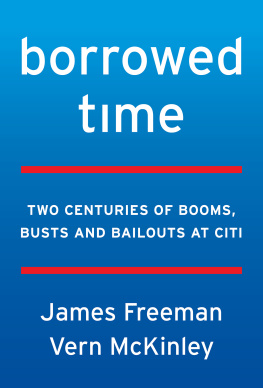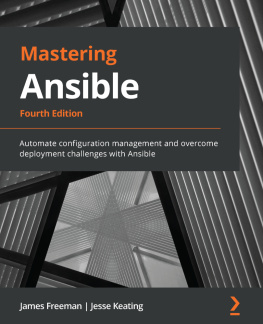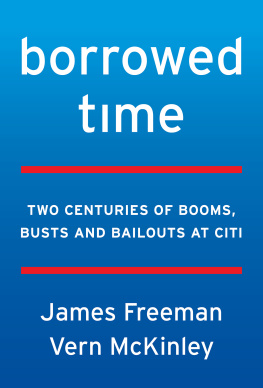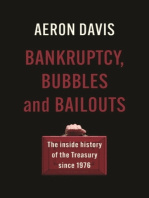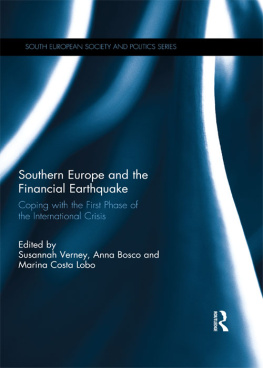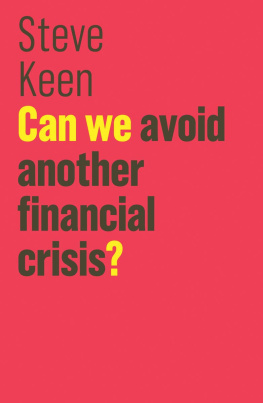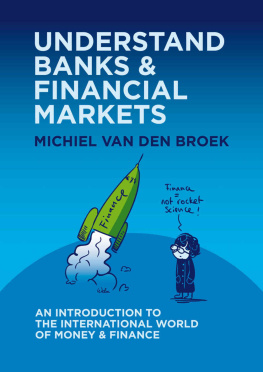Contents
For Nona, Ruben, Catherine, Victoria, Will, Neal, Jane, and Jack.
Dont let it fail, said President George W. Bush. It was a cold and cloudy day in Washington on November 19, 2008. But the climate was even worse in New Yorks financial markets, where investors were increasingly betting that one of the worlds best-known companies wasnt going to make it. Shares of Citigroup, a $2 trillion financial behemoth, plunged 23 percent that day, and were down a full 88 percent since May 2007. An American president who had seemed to understand the value of competition wasnt willing to let a Wall Street giant lose. Just dont let Citi fail, he told Treasury Secretary Hank Paulson.
Mr. Paulson tells this story in his memoir of the financial crisis. But its a story that has unfolded time and again in the century since the federal government began standing behind Citi. The banks rescuers have included politicians and regulators of both parties. A striking number of them didnt believe that Citi deserved its bailouts and doubted whether it could be reformed after taxpayers helped it back from the financial ledge. Some even doubted whether the rescues were necessary. But what they all had in common was that they just couldnt manage to say no.
A few short months after President Bushs Oval Office directive to save the bank, Citigroup CEO Vikram Pandit was back in front of regulators seeking yet another bailout. Dont give up on us, he pleaded with a senior federal official. The government never does.
For obvious reasons, Citis serial bailouts can be infuriating to taxpayers. But what may not be fully appreciated by the public or the press is how destructive the bailout culture connecting Wall Street and Washington can be for the economy and even for the institutions that directly benefit from it. This last point may seem a stretch, given that the company we now call Citigroup is more than two hundred years old and remains one of the largest financial institutions in the world. But our study of Citis two centuries reveals that the bank was in many ways healthier and more stable during the century when it was independent than it has been during the roughly one hundred years in which it has been helped and guided by the federal government.
During the banks era of serial bailouts, Citi has often been presented as the victim of events beyond its controla broader financial panic, unforeseen economic disruptions overseas, or perhaps a perfect storm of credit expansion, private greed, and public incompetence. But through much of its history, Citi not only didnt fall victim to business cycles or financial crises, it actually thrived when others faltered. It became a banking giant precisely because it had the strength to seize opportunitiesand new customersin periods of panic.
As for the economic benefits of bailouts, which are after all undertaken in the name of saving the economy, to this day it remains impossible to prove that the nations financial system couldnt live without Citi or the other financial giants. On the contrary, a sober look back at the financial panic of 2008, informed by eyewitness accounts, turns up new reasons to question the favored status of the banks labeled too big to fail. Can anyone name a single Citi service that couldnt be provided by other companies? And what price are we paying in terms of lost economic growth and innovation by keeping deeply flawed incumbents atop the financial world?
These questions, and in fact any kind of thorough inquiry about Citi, are most unwelcome to the nations regulatory establishment. Weve lately had as much trouble trying to pry records about government assistance to Citi in the 1920s out of the Federal Reserve as many reporters did trying to obtain key information about 2008. The history of instability and government support at Citi is not a story Washington wants to tellor help others tell. This may be why not a single book has focused on Citi and its serial crises, even as multiple books have covered smaller institutions that received far less federal help. The fact that Citi has not received comparable attention may seem especially odd, given the frantic response of its rescuers to its impending doom in late 2008. Treasury Secretary Paulson declared that Citi must not be allowed to fail because, in his view, If Citi isnt systemic, I dont know what is. Citigroup received the most generous government assistance of any bank during the crisis, with capital injections of $45 billion as well as hundreds of billions of dollars of additional help in the form of commercial paper sales, asset guarantees, debt guarantees, and liquidity assistance.
The story of Citi simply does not fit Washingtons explanation of the crisis. Financial regulators and the Wall Street megabanks they oversee like to say the crisis was concentrated in the so-called shadow banking system, the gray area occupied by nonbank financial institutions that were outside the more heavily regulated commercial banking sector. Much of the attention and debate regarding troubled institutions has focused on the failures or near-failures of the nonbank troika of Bear Stearns, Lehman Brothers, and AIG. The 2010 Dodd-Frank Act was sold as a way to give regulators important powers they didnt previously have, to oversee such large, risky firms outside of commercial banking.
But because Citigroup was a federally regulated bank holding company containing a federally insured bank, it was already subject to the full range of supervisory authorities. It had not one but multiple federal banking agencies already overseeing its activities. And perhaps most embarrassing of all to the regulatory establishment, it was specifically overseen by the Federal Reserve Bank of New York and its chief Timothy Geithner, a principal architect of financial crisis policies during both the Bush and Obama administrations. It was for President Obama that Mr. Geithner served as Treasury secretary, and when he stepped down, he was replaced by a former Citi employee named Jack Lew. Dont count on him to expose the full dimensions of this disaster.
* * *
The financial markets can be a rough place, so one could argue that any business lasting so long must be doing something right. And the bank certainly did a lot right in its first one hundred years, although at its origin in 1812, Citi was more like the politically connected operation we see today than the market success it would become for much of the nineteenth century. Created just two days before the start of the War of 1812 and a year after the closing of the First Bank of the United States, City Bank of New York was conceived to serve the needs of both Washington and Wall Street.
Of course, back then Wall Street looked a lot more like Main Street. Before lower Manhattan became the worlds financial center, it was a center for merchants and traders who wanted credit. Without the First Bank of the United States, both New Yorks merchant class and the relatively young national government saw the need for a new provider of financial services. The New Yorkers in particular wanted Gotham to compete with Baltimore, Boston, and Philadelphia as a banking center.
At its start, the bank we now call Citi was no obscure garage start-up. Many of the banks initial stockholders had owned stock in the First Bank of the United States. Citis first president, Samuel Osgood, had been a member of the Continental Congress and Americas first postmaster general. The banks creation was intensely political as rival factions in the New York state assemblyeach aligned with factions in the federal governmentcompeted in a lobbying battle for a state charter. Legislators eventually struck a compromise whereby the faction aligned with President James Madison and the rival group affiliated with Vice President George Clinton each secured a number of board seats in the new enterprise. Though Clinton died two months before the birth of the bank, rival politicos were able to come together in the pursuit of personal, civic, and sovereign advantage.

